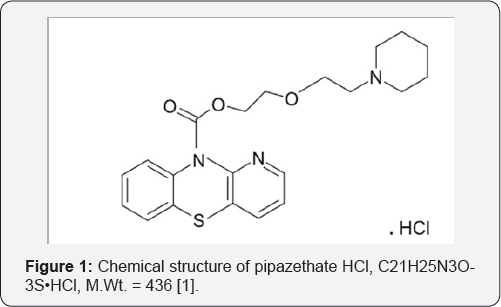Pipazethate HCL toxicity: A Mini Review
Mahmoud Abdelnaby*
Department of Clinical and Experimental Internal Medicine, Medical Research Institute, University of
Submission: December 18, 2017; Published: December 21, 2017
*Corresponding author: Mahmoud Hassan Abdelnaby, Cardiology and Angiology Unit, Department of Clinical and Experimental Internal Medicine, Medical Research Institute, University of Alexandria, Egypt, Tel: 201007573530; Email: Mahmoud.hassan.abdelnabi@outlook.com
How to cite this article: Mahmoud A. Pipazethate HCL toxicity: A Mini Review. J of Pharmacol & Clin Res. 2017; 4(5): 555648. DOI: 10.19080/JPCR.2017.04.555648
Abstract
Pipazethate HCl is a centrally acting non-narcotic antitussive which is rarely used nowadays in developed countries while it is still widely used in developing countries. Drug toxicity is rarely reported in the literature and it includes wide variety of neurological, respiratory and cardiovascular symptoms. The aim of the work was to highlight the manifestations of the toxicity of this drug and to illustrate how to manage them for a better outcome and survival.
Keywords: PipazethateHCl; Torsade de pointes
Introduction
PipazethateHCl is 2-(2-piperidinoethoxy)ethyl 10H-pyrido [3,2-b] [1,4]benzothiadiazine-10-carboxylate hydrochloride [1]. PipazethateHClis a non-narcotic oral antitussive agent that acts centrally on the medullary cough centre [2] (Figure 1).

Side Effects
Prescription of Pipazethate HCl is commonly associated with mild side effects including drowsiness, nausea, vomiting, restlessness, insomnia and urticaria [3].
Drug Toxicity
The main etiology of drug toxicity is related to central depressive effect of the drug [4]. Toxicity of this drug includes a wide variety of symptoms including metabolic neurological, respiratory, and cardiovascular symptoms [5]. Severe metabolic acidosis, hyperglycemia, glucosuria and hyperkalemia are common laboratory findings [5]. Somnolence, agitation, seizures and more frequently coma are the main neurological manifestations in those patients while respiratory symptoms ranges from Kussmaul breathing to respiratory depression and apnea. Neurological and respiratory manifestations are usually related to the central depressive effect of the drug and subsequently death is usually related to serious hypoxia [4].
While cardiovascular toxic manifestations are usually dysrhythmias with ventricular tachycardia and Torsade de pointes or less frequently bradycardia, they can be explained by the fact that PipazethateHCl has a quinidine-like action which results prolongation of QT interval and predisposition to cardiac arrhythmias [6].
Management and Prognosis
A high index of suspicion is required for prompt diagnosis and urgent management is mandatory to prevent the lethality of the drug [7]. Supportive measured has been used for management of the manifestation of toxicity. Arrhythmic complications were managed successfully using magnesium sulphate or lidocaine infusion [5,8]. Antonio da Silva et al. [5] reported a case previously healthy child who had accidentally ingested an unknown quantity of pipazethate HCl and developed severe acute poisoning with neurologic, metabolic, and cardiovascular disturbances. She recovered with symptomatic and supportive therapy and lidocaine bolus and infusion for 4 hours managing ventricular tachycardia. Abdelna by et al. [8] reported a case of accidental ingestion of PipazethateHCl in a 3-years-old child presented with neurological symptoms in the form of somnolence, disturbed sensorium, and respiratory symptoms in the form of respiratory distress and cardiac dysrhythmias in the form of Torsade de pointes. The patient was managed at a critical care unit using supportive measures for neurological symptoms, shock state and respiratory distress. Arrhythmic complications were managed using magnesium sulphate and maintained on lidocaine infusion. After two days under observation, the child was discharged home safely.
Mortality is usually caused by hypoxia due to central respiratory depression or cardiac causes such as ventricular tachycardia, fibrillation and torsade de pointes [4,6]. Bonavita et al. [4] reported a fatality rom Pipazethate HCl toxicity in a 32-month-old female baby. Manifested with tonic-clonic seizures, deep coma, and respiratory deficiency and died shortly after due to apnea.
Conclusion
The use of centrally acting antitussives is markedly decreased nowadays in developed countries, but financial barriers make them still widely prescribed in developing countries. PipazethateHCl toxicity is extremely rare and it is only reported 5 times in the literature hence awareness about its side effects and toxic manifestation scan improve the overall survival.
References
- El-Saharty YS, El-Ragehy NA, Abdel-Monem HM, Abdel-Kawy MI (2010) Stability-indicating methods for the determination of pipazethate HCl in the presence of its alkaline degradation product. Journal of Advanced Research 1(1): 71-78.
- Vakil B, Mehta A, Prajapat K (1966) Trial of pipazethate as an antitussive. Clinical Pharmacology & Therapeutics 7(4): 515-519.
- Pipazethate (2017) Side Effects, Precautions, Drug Interactions.
- Bonavita V, Crino C (1982) Accidental lethal pipazethate poisoning in a child. International Journal of Legal Medicine 89(2): 145-148.
- Antonio da Silva O, Lopez M (1977) Pipazethate-Acute Childhood Poisoning. Clinical toxicology. 11(4): 455-458.
- Giuliano H (1970) A comparison of the cardiac activity of a new antiarrhythmic drug--pipazetate--with quinidine, procainamide, antazoline and diphenylhydantoin. Archives internationales de pharmacodynamie et de therapie 188(1): 189-199.
- Soto E, Ochoa Z, Alvarado H, Espinoza O, Irastorza I, et al. (1993) Pipazethate lethality in a baby. Veterinary and human toxicology 35(1): 41.
- Abdelnaby M, Ibrahim M, AbdulHaleem M (2017) Acute Pipazethate HCl (Selgon, Eipico Egypt, Egypt) Toxicity: Case Report. J Clin Toxicol 7(356): 2161-2495.






























